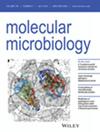胸膜肺炎放线杆菌与其遗传环境的军备竞赛:其防御和移动遗传因素的综合分析
IF 2.6
2区 生物学
Q3 BIOCHEMISTRY & MOLECULAR BIOLOGY
引用次数: 0
摘要
胸膜肺炎放线杆菌是猪胸膜肺炎的病原体,是一种具有高度传染性和经济意义的疾病。胸膜肺炎假单胞菌的遗传变异性使疾病控制工作复杂化,因为它能够快速适应各种压力源,包括抗菌治疗。为了更好地理解这种适应性的分子机制,我们研究了细菌防御体的作用及其与移动遗传元件(MGEs)的关系,如噬菌体、质粒和整合共轭元件(ICEs)。利用生物信息学工具,我们在胸膜肺炎假体中发现了一个多样化和丰富的防御体,每个菌株平均有16种不同的防御系统。我们发现CRISPR-Cas系统与其他防御机制一起,积极参与限制外来遗传物质的进入,在细菌适应中起着至关重要的作用。此外,我们鉴定了几种新的噬菌体,并检查了它们在不同菌株中的分布,揭示了它们对细菌进化成功的潜在贡献。我们的发现强调了细菌防御系统和MGEs之间复杂的相互作用,揭示了胸膜肺炎杆菌如何在保持遗传多样性的同时保护自己免受外部威胁。这些见解提供了对影响病原体适应性的遗传因素的更好理解,并强调了更有效的疾病控制策略的潜在途径。本文章由计算机程序翻译,如有差异,请以英文原文为准。

The Arms Race Between Actinobacillus pleuropneumoniae and Its Genetic Environment: A Comprehensive Analysis of Its Defensome and Mobile Genetic Elements
Actinobacillus pleuropneumoniae is the causative agent of pleuropneumonia in swine, a highly contagious and economically significant disease. The genetic variability of A. pleuropneumoniae complicates disease control efforts, as it enables rapid adaptation to various stressors, including antimicrobial treatments. To better understand the molecular mechanisms underlying this adaptability, we investigated the role of the bacterial defensome and its relationship with mobile genetic elements (MGEs), such as prophages, plasmids, and integrative conjugative elements (ICEs). Using bioinformatic tools, we identified a diverse and rich defensome in A. pleuropneumoniae, with an average of 16 different defense systems per strain. We found that CRISPR-Cas systems, along with other defense mechanisms, are actively involved in restricting the entry of foreign genetic material, playing a crucial role in bacterial adaptation. Additionally, we characterized several novel prophages and examined their distribution across different strains, revealing their potential contribution to the bacterium's evolutionary success. Our findings underscore the complex interplay between the bacterium's defense systems and MGEs, shedding light on how A. pleuropneumoniae maintains genetic diversity while also safeguarding itself against external threats. These insights provide a better understanding of the genetic factors that influence the pathogen's adaptability and highlight potential avenues for more effective disease control strategies.
求助全文
通过发布文献求助,成功后即可免费获取论文全文。
去求助
来源期刊

Molecular Microbiology
生物-生化与分子生物学
CiteScore
7.20
自引率
5.60%
发文量
132
审稿时长
1.7 months
期刊介绍:
Molecular Microbiology, the leading primary journal in the microbial sciences, publishes molecular studies of Bacteria, Archaea, eukaryotic microorganisms, and their viruses.
Research papers should lead to a deeper understanding of the molecular principles underlying basic physiological processes or mechanisms. Appropriate topics include gene expression and regulation, pathogenicity and virulence, physiology and metabolism, synthesis of macromolecules (proteins, nucleic acids, lipids, polysaccharides, etc), cell biology and subcellular organization, membrane biogenesis and function, traffic and transport, cell-cell communication and signalling pathways, evolution and gene transfer. Articles focused on host responses (cellular or immunological) to pathogens or on microbial ecology should be directed to our sister journals Cellular Microbiology and Environmental Microbiology, respectively.
 求助内容:
求助内容: 应助结果提醒方式:
应助结果提醒方式:


